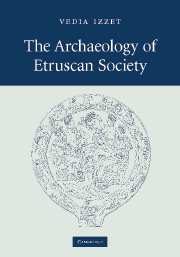Book contents
- Frontmatter
- Contents
- List of illustrations
- Acknowledgements
- List of abbreviations
- Introduction
- 1 Models of change in Etruria
- 2 Etruscan mirrors: reflections on personal and gender identity
- 3 Funerary architecture: the living and the dead
- 4 Sanctuaries: the sacred and the profane
- 5 Domestic architecture: public and private
- 6 Urban form and the concept of the city
- 7 Making Etruscan society: culture contact and (material) culture change
- Bibliography
- Index
1 - Models of change in Etruria
Published online by Cambridge University Press: 10 May 2010
- Frontmatter
- Contents
- List of illustrations
- Acknowledgements
- List of abbreviations
- Introduction
- 1 Models of change in Etruria
- 2 Etruscan mirrors: reflections on personal and gender identity
- 3 Funerary architecture: the living and the dead
- 4 Sanctuaries: the sacred and the profane
- 5 Domestic architecture: public and private
- 6 Urban form and the concept of the city
- 7 Making Etruscan society: culture contact and (material) culture change
- Bibliography
- Index
Summary
Introduction
This chapter sets out the theoretical basis on which the analysis of the following chapters takes place. First it considers some of the approaches that have underpinned and characterised previous studies of Etruscan material culture change; next it draws on recent developments in the wider discipline of archaeology and beyond in order to establish a theoretical model for the following chapters.
Models of change in Etruria
This section examines the characteristics of previous treatments of Etruscan material with particular emphasis on how change in material culture has been approached. Its aim is to open discussion about certain assumptions that have been implicit in previous treatments, and to highlight the limitations of such approaches for our understanding of Etruscan culture more widely. Though this section may often seem critical of these approaches, much of the work of the following chapters is based on their conclusions. The analyses in the rest of the book take for granted the chronological and cultural framework established by such work; they aim not to contradict them, but to push their conclusions further.
Classical studies
One of the most important factors affecting the study of the Etruscans has been the closeness of the subject to the discipline of Classics. Both within and outside Italy, the study of the Etruscans has proceeded concurrently with the study of Greece and Rome and this has had a significant influence on the way in which Etruscan culture has been studied.
- Type
- Chapter
- Information
- The Archaeology of Etruscan Society , pp. 10 - 42Publisher: Cambridge University PressPrint publication year: 2007

